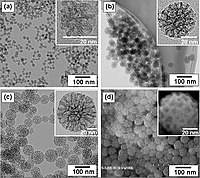
Photo from wikipedia
Abstract Co3O4/N-doped graphene is synthesized with a one-pot and low-cost thermal decomposition in air. N-doped graphene improves their reductivity and their low-temperature catalytic performance of CO oxidation. After the treatment… Click to show full abstract
Abstract Co3O4/N-doped graphene is synthesized with a one-pot and low-cost thermal decomposition in air. N-doped graphene improves their reductivity and their low-temperature catalytic performance of CO oxidation. After the treatment with dry reaction gases, the treated composites show the changed chemical structure of nitrogen species from N (C)3 structure to C N C structure. After the treatment with wet reaction gases, nitrogen species on N-doped graphene are decomposed and the anchored sites of Co3O4 nanoparticles are converted into oxygenated groups. The nitrogen sites of N (C)3 structure are beneficial to promote the reversible conversion between the reduced Co2+ ions and active Co3+ ions on Co3O4 nanoparticles at low temperature, but Co3+ ions can irreversibly be converted into the reduced Co2+ ions on Co3O4 nanoparticles anchored at the nitrogen sites of C N C structure and it is more difficult to reduce Co3O4 nanoparticles anchored at oxygenated groups from the converted nitrogen species. Since CO oxidation is promoted by the reversible conversion between Co2+ ions and Co3+ ions on Co3O4 nanoparticles, Co3O4/N-doped graphene has low-temperature catalytic activity, but the composites treated with dry reaction gases require higher temperature to show catalytic activity and the composites treated with wet reaction gases show lower catalytic performance.
Journal Title: Applied Surface Science
Year Published: 2020
Link to full text (if available)
Share on Social Media: Sign Up to like & get
recommendations!